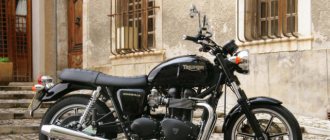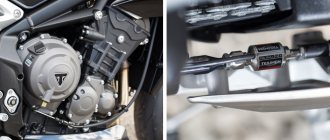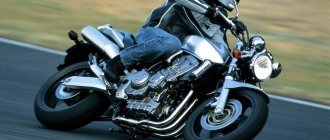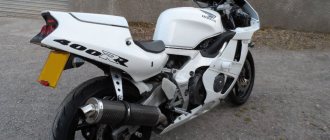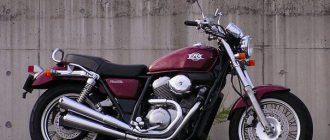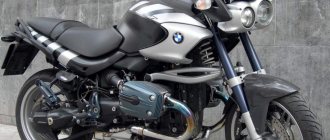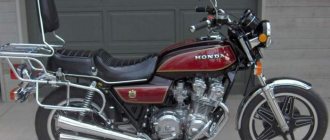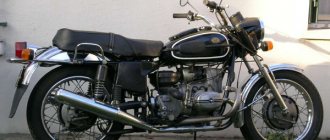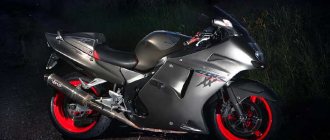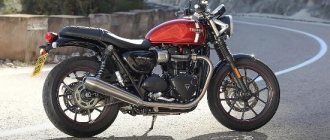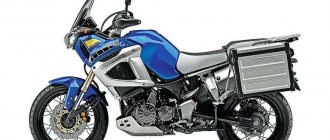Delivery to any city in Russia, Belarus and Kazakhstan.
Profitable trade-in New motorcycle from an official dealer. Official warranty for the motorcycle is 2 years without mileage limitation.
Due to the black color of almost all components of the motorcycle, the Bonneville T100 Black has become even more refined and presentable, it looks like a real urban dandy.
CUSTOMIZED IN EVERYTHING Superiorly crafted and affordable, the Bonneville T100 Black motorcycles complement and expand Triumph's legendary Bonneville family of classic motorcycles.
Their style traces the family features of the classic Bonnies, because the models are inspired by the style icon - the 1959 Bonneville motorcycle, but this does not prevent them from demonstrating their distinctive features - meticulous execution and attention to detail.
The real highlight of these motorcycles is the high-torque, high-tech 900 cc power unit, which gives the new products enviable fuel efficiency, a special character and sound, which is complemented by parts and elements taken from the “older” model – the Bonneville T120.
Benchmark ride quality is another strong point of the Bonneville T100 Black. Handling is light and precise thanks to meticulous chassis tuning, new suspension components and electronic aids such as traction control, slipper clutch and ABS braking system. New technologies work for the comfort and safety of the driver and passenger.
TRUE TO TRADITION The Bonneville T100 Black remains true to the British traditions of the motorcycle industry with its always recognizable silhouette, traditional fuel tank shape, spoked wheels, authentic extended mufflers, and two-tone hand-painted paint.
BEAUTY IS IN THE DETAILS Every detail of the Bonneville T100 Black is beautiful and delights with its execution and finishing. The combination of quality chrome and brushed aluminum engine covers, as well as bolted-on Triumph logos on the tank, make the new Bonneville T100 Black truly unique.
TORQUE 900 cc ENGINE BONNEVILLE T100 Black are distinguished by a high-torque Bonneville engine with a displacement of 900 cc, which has excellent dynamic qualities, good fuel efficiency and an unforgettable deep exhaust sound.
The engine has an 8-valve gas distribution system with a single overhead camshaft, a 270-degree interval between flashes allows the parallel “two” to produce torque smoothly and smoothly. The gear ratios of the 5-speed gearbox are also designed taking into account the specific engine design and maximum efficiency.
EXCITING SOUND AND STYLE The Bonneville T100 Black is powered by a torquey, classic British twin-cylinder engine that delivers performance as well as execution. The monumental silhouette of the power plant is combined with an elegant exhaust system, which is crowned with stylish classic elongated mufflers like the model from the past - 59′ Bonneville. The system sounds as amazing as it looks – rich and expressive, like a true British classic.
ENGINE AND TRANSMISSION
- ENGINE TYPE 2-cylinder in-line water-cooled, DOHC, ignition interval - 270 degrees
- ENGINE CAPACITY 900 cm3
- POWER 54 hp (40.5 kW) at 5900 rpm
- TORQUE 80 Nm at 3230 rpm
- CYLINDER DIAMETER 84.6 mm
- PISTON STROKE 80 mm
- INJECTION SYSTEM MULTIPOINT electronic injection with SAI
- EXHAUST SYSTEM Two chrome-plated mufflers, located on both sides
- WHEEL DRIVE X-ring chain
- CLUTCH Multi-disc in oil bath
- GEARBOX 5-speed
- OIL CAPACITY 4.5 l
Design and construction features
A city scooter should be lightweight. It is not required to drive aggressively between pedestrians, and certainly not to storm the roadway. So the Triumph T100, built on an aluminum frame, does an excellent job of getting the rider from point A to point B faster than on foot, but at the same time without provoking dangerous situations.
The deck of the scooter is quite long, although narrow. I have a size 43 foot and I feel comfortable standing on the Triumph T100 with my feet one behind the other.
You cannot stand on the rear wing; it does not have a brake function and is made of plastic. It protects well from splashes in wet weather, so you don’t have to worry about the cleanliness of your jeans.
The steering column is not adjustable, but quite high. My height is 183 cm and the steering wheel is at the most optimal height for me, approximately at stomach level. So the arms do not stretch out, are in a slightly bent state and do not get tired of holding onto the grips while riding.
On the steering column you can find a standard set of controls: on the left is a mechanical disc brake handle that stops the front wheel, a bicycle bell that will warn pedestrians about your movement, and under the finger of your right hand is the gas trigger.
In the middle of the steering column there is an on-board computer screen and a button to turn on the scooter. The screen displays the main parameters - the current speed, an indicator of battery charge and activation of the headlight, as well as an indicator of first or second gear, which allow you to reach different speeds.
Yes, about the speed: the Triumph T100 rides smoothly, but confidently, without jerking. You can safely give it to a teenager or a fragile girl - there will be no problems, falls, fear or skinned knees.
The motor is located in the rear wheel, its power is 350 W, and at peak loads it can reach 500 W. It is powered by a battery built into the deck. Battery capacity – 288 Wh, 36 V, 8 Ah. This is enough to transport a person weighing up to 130 kg.
The wheels are 10 inches, inflatable, which makes riding on uneven tiles more comfortable.
The main secret of comfort is the front suspension fork, which absorbs bumps, holes and other imperfections of domestic sidewalks. So after riding, you won't want to ice your wrists or book a lower back massage.
Well, one of the nice little things is that the scooter has IPX4 water protection, so light summer rain and shallow puddles will not cause any harm to the Triumph T100.
CHASSIS, SUSPENSION AND ELECTRONICS
- FRAME Steel tubular frame
- REAR SWIMMER Double-sided steel swingarm
- FRONT WHEEL Spoke wheel, 32 spokes, 18 x 2.75 inches
- REAR WHEEL Spoke wheel, 32 spokes, 17 x 4.25 inches
- FRONT TIRE 100/90 R 18
- REAR TIRE 150/70 R 17
- FRONT SUSPENSION KYB fork, stay diameter - 41 mm, travel - 120 mm
- REAR SUSPENSION Two KYB shock absorbers with preload adjustment, rear wheel travel - 120 mm
- FRONT BRAKE Single 310mm brake disc, 2-piston Nissin caliper, ABS
- REAR BRAKE Single 255mm disc, Nissin 2-piston caliper, ABS
- INSTRUMENT PANEL Instrument panel with analogue speedometer and analogue tachometer. The instrument panel displays: gear indicator, odometer, two trip meters, service indicator, mileage on the tank, fuel level in the gas tank, average and instantaneous fuel consumption, clock, status of heated handlebars, status of the stability control system and motorcycle operating modes.
Test drive Triumph Bonneville T100
I stopped turning on the turn signals after about fifteen minutes. Not because my finger did not fit on the old-mode switch as comfortably as I would like. It’s just that the agility of the big one on the left hand was categorically inferior to the agility of me in a duet with the expressionless-looking and graceful “to the touch” Triumph Bonneville T100 motorcycle. For almost the first time, I caught myself thinking that I was moving in a dense stream much faster than I had intended.
Having sung Sting’s “gentleman will walk, but never run” to myself, I exhale noisily into the visor of my own helmet, stop and dismount, parking the two-wheeler in sight. Well, yes, I had a childhood too. It was Soviet, and in this Soviet childhood there was nothing more desirable (the word “cooler” was not yet in use then) than the 350th “Java”. We looked at it with all our eyes then, and literally idolized its rare owners.
At Triumph everything looks the same. A laconic exterior with “corrugated” front forks and a precisely contoured front fender.
The same lonely headlight framed by turn signals sticking out to the sides and “Mickey Mouse ears” rear view mirrors. Well, how, how were we, Soviet children, supposed to know that all these were actually distinctive features of the first “Bonnevilles” from the 50s?
Cooling down before my eyes, the T100 is like two drops of water similar to its predecessors. Similar down to the smallest detail. Here, for example, is the 1968 “Bonnie” T120. Find ten differences! Well, or as much as you can.
We are accustomed to consider traditionalism a rather British trait. Therefore, anyone who decides to compare “my Bonya” with “some kind of reality” will immediately receive a spanking: “What are you talking about! This is a real British!”
Although I myself look at the Bonneville and constantly come across, let's say, not very British details. Behind the anti-reflective glass are two dials of German VDO instruments. Metzeler tires come from the same place, from the country of beer and sausages and cabbage. The front fork and shock absorbers are completely Japanese, Kayaba. The brakes are also from the “rising sun”, they are made by Nissin.
But in the end, what difference does it make?
The main thing is that the Bonneville T100 is the same dandy bike that it was half a century ago.
And God forbid you confuse a true dandy with a modern hipster. Yes, “dandyism” also presupposed the perfection of form, dominating the beauty of the content, but in those days this perfection extended somewhat beyond printed T-shirts.
And the character of “Bonnie” is from the same place, from the “real” era. After all, what difference does it make where the suspension components are made if it is tuned in such a way that it gives the motorcycle that slightly careless grace of true dandies, for which the Italians even came up with a special term - la Sprezzatura?
The Bonneville T100 is easy to drive in the entire speed range available to it - from walking through traffic jams to the brink of losing your driver's license. Even faster? It's possible, but not necessary. Firstly, it blows away, and secondly, it no longer has enough gears. And, of course, the engine is to blame for this.
The two-cylinder “air” with overhead camshafts and a power of 68 horsepower moves through all five gears so easily that the leg, in dullness, tries to pull the “foot” up for some time, as if refusing to believe that this is all. The elasticity of the engine is such that it allows you to close the urban range at any stage - from the second to the last. You can, for example, make a gentleman's bet that you will be able to travel all day on third. And pass the test with honor, never falling behind the flow even during traffic light starts.
But (a “but” must appear here), even despite the torquey engine and refined handling, the Triumph Bonneville should in no way be considered a streetfight car. Firstly, because Sting is right - “a gentleman will walk...” And secondly, “Bonnie” seriously lacks brakes. One front disc is, of course, stylish, but not enough.
So all that remains is to return to everyday travel at speeds that fit within the bounds of decency, and once again discreetly regret that such a stylish motorcycle is completely devoid of what is called the “wow effect”.
In other words, he is “underwhelming.” We are, of course, talking about those around us. True, this is more than compensated by the exorbitant respect from those who are “in the know,” but the non-churched buyer has the right to ask the question: is it worth it?
The Triumph Bonneville T100 costs nearly half a million, and we can safely say that the totality of consumer properties pays off the probable costs by ninety percent. The remaining ten are left to be chewed off by the worm of doubt, which will certainly remind you of a huge number of alternatives, which include lightweight enduros from BMW, and the quite charismatic Ducati Monster, and the HD Sportster, and even 1200 cc Moto Morini motorcycles. In general, there are many options, and everyone will find at least a microscopic advantage over Bonnie.
Triumph
Triumph has updated its Bonneville motorcycle lineup to celebrate the model's 50th anniversary.
A pleasant surprise for Bonneville fans was the upgrade of the fuel system to an injector. The legendary powerplant has now become better. In 2009, Triumph Bonneville entered a new era of performance, style and nostalgia with a diverse range of models. The classic Bonneville T100 features spoked wheels, a unique exhaust and a two-tone paint scheme, as well as a chrome engine.
The 2010 Bonneville features 17-inch alloy wheels, a Thruxton-style exhaust and sporty fenders. The seating position on motorcycles is slightly different due to different saddle heights and saddle widths. But despite everything, the modern Bonneville has classic design lines. Obviously, the 2010 Bonneville SE is the same as the standard model, only it comes in two colors. Additionally, the SE has a speedometer, tachometer and a chrome Triumph badge on the tank.
At the heart of all three motorcycles is an 865cc inline-twin engine with multi-point electronic fuel injection. Triumph had to install an injector to ensure the engine met environmental standards. Engine power reaches its peak of 66 hp. at 7500 rpm, and 69 Nm of torque at 5800 rpm.
So what is the difference between the three models?! The Bonneville and SE are shorter and slightly wider than the T100, and also have a 27* fork rake and 106mm trail versus the classic model's 28* fork rake and 110mm trail. The Bonneville's fuel tank holds 13.2 liters of fuel, while its sibling's fuel tank holds 15.9 liters.
Technical characteristics of Triumph Bonneville 2010:
• Engine: Air-cooled, twin-cylinder, DOHC • Displacement: 865 cc • Bore x Stroke: 90 x 68 mm • Compression Ratio: 9.2:1 • Fuel System: Multiport Sequential Electronic Fuel Injection with SAI • Final Drive: Chain • Clutch: Multi-plate clutch in oil bath • Gearbox: 5 speeds • Power: 66 hp. at 7500 rpm • Maximum torque: 68 Nm at 5800 rpm • Frame: tubular steel • Front wheel: aluminum alloy, 7 spoke, 17 x 3.0 • Rear wheel: aluminum alloy, 7 spoke, 17 x 3.5 • Front tire: 100/70 R17 • Rear tire: 130/80 R17 • Front suspension: 41 mm Kayaba fork, 120 mm travel • Rear suspension: Kayaba shock absorber, pair, adjustable, 100 mm travel • Front brake: 310 mm disc, caliper Nissin 2-piston • Rear brake: 255mm disc, Nissin 2-piston caliper • Length: 2113mm • Width (Handlebar): 790mm • Height: 1130mm • Seat height: 739mm • Wheelbase: 1488mm • Tilt/Trail: 27 */ 106 mm • Wet weight: 225 kg • Fuel tank capacity: 15.9 l
